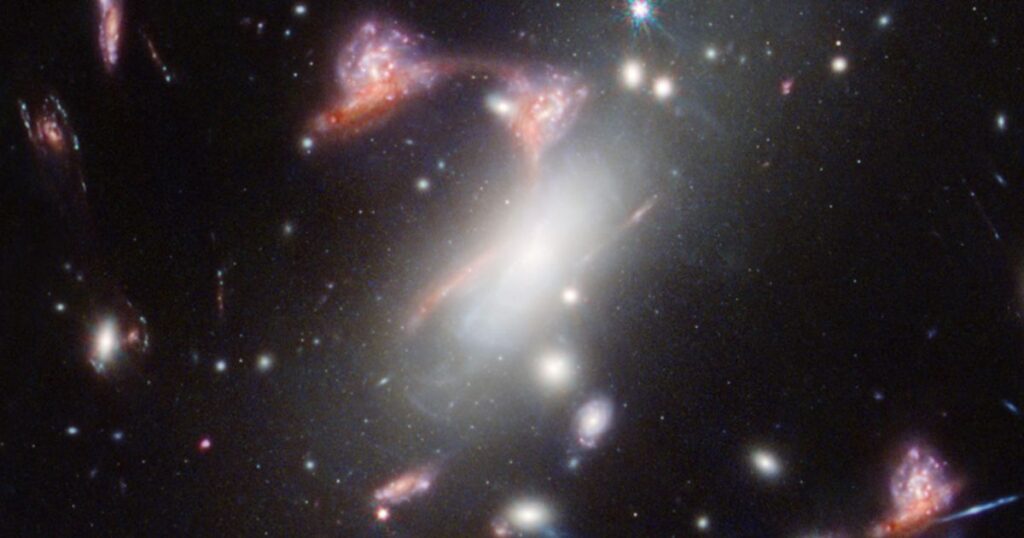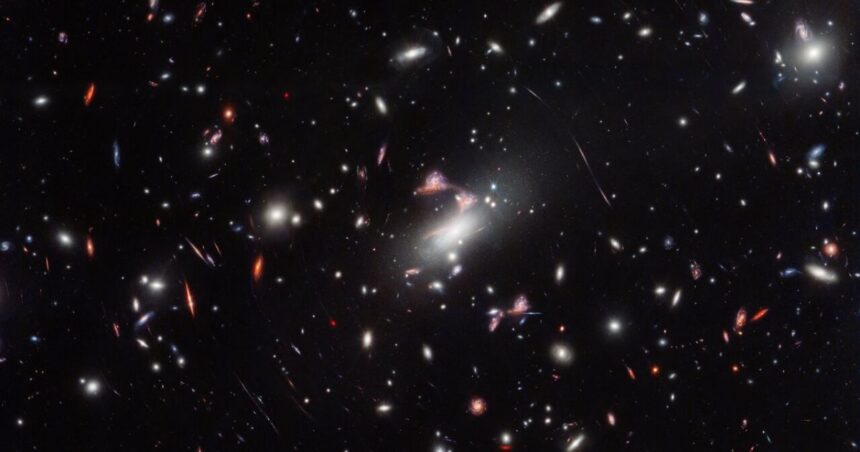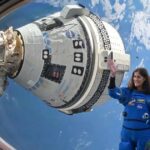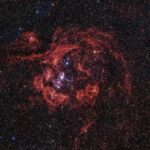NASA’s James Webb Space Telescope (JWST) has proved once again that it is the world’s best telescope by discovering the details about star formation during the Universe’s “Cosmic Noon.” This new discovery of the James Webb Space Telescope could be very important for scientists. The universe’s Cosmic Noon period was seven billion years ago when star formation was at its peak.
Gravitational lensing
The galaxies detected by the James Webb Space Telescope are located behind a large galaxy cluster named MACS-J0417.5-1154. The telescope detected two galaxies behind this large galaxy cluster that were about to begin merging. MACS-J0417.5-1154 cluster acts as a gravitational lens, magnifying the light from behind galaxies and making them visible to the JWST.
Gravitational lensing allows scientists to see these two galaxies as they were a few billion years ago. One of these two galaxies is blue in colour and is a spiral galaxy, and the second galaxy is dusty red in colour, an edge-on galaxy. The JWST’s powerful instruments captured these galaxies in unprecedented detail. Images captured by JWST show light from these galaxies is an arc shape due to the gravitational lensing effect.
Star Formation Rate (SFR)
Gravitational lensing produces many photos of a galaxy, but each photo has different magnification and brightness. All this information is very important for realizing the star formation rate (SFR) in galaxies. Some galaxies are starburst galaxies with a very high star formation rate (SFR), while other galaxies have very low SFRs. By studying these galaxies, astronomers can learn how SFRs vary in different regions of the galaxies.

(Image Credit: NASA)
The JWST’s findings are part of the Canadian NIRISS Unbiased Cluster Survey (CANUCS). This team of astronomers, led by Guillaume Desprez of Saint Mary’s University in Halifax, Nova Scotia, is excited about the results. Desprez says, ‘we know only three to four gravitational lensing configurations in our universe.’ This finding demonstrates the power of the James Webb Space Telescope and tells us that many such gravitational lensing configurations can be found.
The JWST’s ability to see these distant galaxies is a testament to its advanced technology. The telescope’s instruments can capture light from objects that are billions of light-years away. This capability allows astronomers to study the Universe’s history in incredible detail.
The JWST shows not only star formation rates (SFRs) but also the composition and structure of the galaxy itself. The blue galaxy is rich in young, hot stars, while the red galaxy is filled with older, cooler stars and dust. This contrast helps astronomers understand how galaxies evolve. These findings of JWST also help to refine models of galaxy formation and evolution.
By comparing the JWST’s data with theoretical models, astronomers can test their predictions and improve their understanding of the Universe. All these findings play a very important role in studying star formation. It provides a snapshot of a time when the universe was teeming with new stars. This period is known as the “Cosmic Noon” and was an important time in the universe’s history.
This finding tells us that there are many more mysteries in our universe that we need to unravel and that we can learn more about our universe. The JWST is helping to answer some of the biggest questions in astronomy. But it is also raising new ones. What other secrets does the Universe hold? What will the JWST discover next?
The JWST’s observations of star formation at Cosmic Noon are just the beginning. The telescope still has a lot to discover. Each of these findings brings us closer to the mysteries of the universe.
Editor’s Recommendations
- CNRS Study Reveals ‘Secret Life’ Before The Big Bang! Mind-Blowing Discovery
- Saturn Rings Disappear by 2025, Will We Ever See Them Again?
- Asteroid Bennu Older Than the Sun and a Carrier of Life’s Building Blocks and Water on Earth
- NASA’s Europa Clipper Spacecraft Prepares for Historic Launch, A New Chapter in the Search for Extraterrestrial Life




